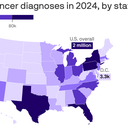New cancer diagnoses expected to hit record high this year

New cancer diagnoses in the U.S. are expected to top 2 million for the first time in 2024, driven in large part by an alarming increase in cancers among younger Americans, according to new American Cancer Society data.
Why it matters: There have been major improvements in cancer survival, but there's a worrying rise in some cancers at the same time doctors are trying to figure out why they're seeing more young patients with cancer.
What they're saying: This demographic shift comes with psychological, physical and financial burdens that are less common with older patients, experts say.
- Patients under 50 are more likely to be uninsured, juggling career and caregiving responsibilities, and face a higher lifetime risk of treatment-related side effects like second cancers.
- "It's overwhelming for anybody, but especially for these younger patients who are going on with their daily lives and then suddenly get this life-altering diagnosis and really don't know where to turn," Robin Mendelsohn, co-director of the Center for Young Onset Colorectal and Gastrointestinal Cancers at Memorial Sloan Kettering, told Axios.
- "Many feel alone because they're younger, their friends, many haven't had to deal with this."
Zoom in: The proportion of people 65 and older diagnosed with cancer dropped from 61% to 58% in the last 30 years, even as the size of that group increased. The proportion of those diagnosed between ages 50-64 was largely stable.
- "Notably, people aged younger than 50 years were the only one of these three age groups to experience an increase in overall cancer incidence during this time period," the ACS report said.
- Doctors don't know exactly what's behind the uptick in new cases and deaths among younger patients in many cases.
While new cases of colorectal cancer — the leading cause of cancer death in men under 50 and the second-leading cause of cancer death in women under 50 — have been declining among adults 65 and older, they've increased 1% to 2% annually in people younger than 55 since the mid-1990s.
- "Colorectal cancers are also presenting with more aggressive disease and larger tumors at diagnosis," ACS chief scientific officer William Dahut told Axios.
- Researchers are examining whether long-term factors like consumption of red meat or ultra-processed food, medication and vitamin use, and obesity are contributing to this shift.
- "Cancer obviously takes time to grow, especially colon cancer. So we think it's probably exposures from decades prior," Mendelsohn said.
- Preliminary MSK research found significant differences in the microbiomes of early-onset colorectal cancer patients compared with older ones. More research is needed but "this might be a signal," she said.
The big picture: The U.S. cancer death rate has been cut by a third in the last 30 years, partly due to improved screening, a sharp drop in smoking, and more effective treatments against certain cancers.
- But diagnoses have been increasing for some cancers, and there are strong racial and ethnic disparities in cancer deaths.
- New cases of prostate, liver, kidney and HPV‐associated oral cancers and melanoma each rose 2% to 3% annually between 2015 and 2019.
- Cases of breast, pancreas and uterine cancers also increased between .6% and 1% annually during that time.
- Black people were twice as likely to die from prostate, stomach and endometrial cancer compared with white people between 2016 and 2020. Mortality rates were also twice as high for Native American people for liver, stomach and kidney cancers in that same time frame.
The ACS projections exclude data from 2020, when the pandemic's first year led to a drop-off in cancer screenings.
- The largest delays in diagnoses appeared to be for cancers that tend to be less fatal or asymptomatic, according to ACS. For instance, there was a 16% drop for melanoma diagnosed in men and an 18% drop in thyroid cancer diagnosed in women that year.
- "The question of whether these delays lead to increased diagnosis of advanced‐stage disease and, ultimately, higher cancer mortality at the population level will be answered gradually over many years," the authors wrote.
Of note: There is some good news in the data. The decline in cancer mortality has resulted in more than 4 million fewer deaths in the U.S. since 1991.
- Still, the study projects cancer will kill nearly 612,000 people this year, up from a projected 609,820 in 2023.
The bottom line: Dahut said the study highlights the importance of timely screening, particularly among people with a strong family history of cancer or who are experiencing symptoms of the disease.
- "Most things, of course, won't be cancer. But if things seem abnormal, make sure you know you are satisfied by the workup," Dahut said.